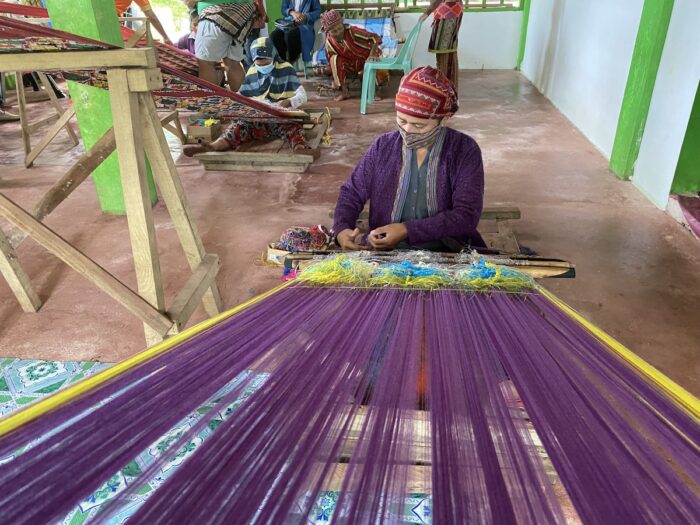Tennun: The Yakan Weaving Tradition
11 min read
Tennun: Showcasing Yakan Artistry Through Traditional Weaving
Tennun is a traditional handweaving technique of the Yakan tribe in Basilan, Philippines. The term “tennun” refers to the handwoven fabric produced by the skilled weavers of the community. The Yakan people, known for their vibrant culture, have been practicing this craft for generations, passing down their knowledge and skills from one generation to the next.
The art of Tennun involves weaving threads on a traditional loom to create intricate patterns and designs. The weavers use a variety of materials, including cotton, abaca, and silk, to produce the fabric. The resulting textiles are known for their bright colors, bold patterns, and high quality. The Yakan people use Tennun fabric for various purposes, including clothing, household items, and ceremonial attire.
Today, Tennun is not only a source of pride for the Yakan people but also an important part of their livelihood. The weavers sell their handwoven products to both local and international markets, generating income for their families and communities. The demand for Tennun products has also led to the establishment of weaving centers and cooperatives, providing employment opportunities for more weavers and helping to preserve the tradition for future generations.
The Yakan Tribe
The Yakan Tribe is one of the major indigenous Filipino ethnolinguistic groups in the Sulu Archipelago. They are known for their weaving tradition called Tennun, an artistic ability that is a source of pride for Yakan women. The Yakan people mainly reside in Basilan but are also found in Zamboanga City.
The Yakan Tribe has a rich history and culture deeply rooted in their identity. They have their own language, called Yakan, and practice Islam as their religion. The Yakan people have a strong sense of community and are known for their hospitality and kindness towards visitors.

In 2016, Ambalang Ausalin, a Tennun weaver from the Yakan Tribe, was recognized by the Philippine government as a National Living Treasure for its weaving artistry. This recognition was given to individuals or groups who possess outstanding knowledge and skills in traditional arts that are important to Philippine culture and heritage.
Despite facing challenges such as conflict and displacement, the Yakan people have managed to preserve their culture and traditions. They continue to pass on their weaving tradition from generation to generation, ensuring that their heritage lives on.
Traditional Yakan Weaving
Yakan women are known for their expertise in weaving and use this skill to create beautiful and intricate designs on their traditional costumes and other woven items.
Weaving Techniques
Yakan weaving is done using a back-strap loom or a body-tension loom. The loom comprises a warp beam, heddles, and a shuttle. The weaver sits on the floor with the loom controlled by her body. The warp threads are tied to a stationary object, and the weaver uses her body to create tension on the threads. This tension allows the weaver to create the patterns and designs on the cloth.
Yakan weaving techniques are passed down from master weavers to apprentices. The intricate Bunga-sama, or “fruit of the ancestors”, is a unique design or category of cloth or weaving with a rice grain-like motif, often featuring elaborate and bolder designs. This type of cloth is reserved for high-status Yakan, and can be seen in the form of blouses and pants, as well as suwah bekkat (cross-stitch-like embellishment) and suwah pendan (embroidery-like embellishment) pieces.
The motifs of the Bunga-sama are inspired by the plants and animals of the Yakan’s surroundings, and more importantly, their great respect for the “paley (rice)”, with diamonds and grain-like motifs often seen across the span of the warp.
The master weaver, Apuh Ambalang, can create the Bunga-sama teed peneh pitumpuh (the cloth with seventy-designs; at times with seven different colors of thread), the peneh sawe-sawe (snake skin-like), peneh dawen-dawen (leaf-like), peneh palipattang (rows of unhusked grains or grain-like), peneh kenna-kenna (fish-like), peneh manuk-manuk (bird-like), peneh kaka-kaka (crab-like), and the peneh ampat kaban-buddi (four diamonds within a frame; patchwork-like). The intricacies and detail of the Bunga-sama are a testament to the Yakan’s reverence for the “paley (rice)”.

Types of Weaves
Yakan weavers create a variety of woven items such as table runners, pillowcases, placemats, and bags. The complexity of the weaving is divided into different categories such as Seputangan, Bunga-sama, Sinulu’an, Inalaman, Pussuk Labbung, and Pinatupan. Each category has its own unique style and design.
The Yakan traditional costume is the most famous woven item of the Yakan community. The traditional costume is made up of a skirt, blouse, and headscarf. The cloth used for the costume is made of cotton and pineapple cloth. The design of the costume is usually geometric and features bright colors.
Significant Textiles and Products
The Yakans of Basilan province have long been renowned for their beautiful and intricate weaving tapestry tradition of Tennun. Colorful fabrics with unique patterns and designs adorn various items, from accessories and bags to clothes and decorations, creating a dazzling array of products. The fabrics produced through this technique have a high historical value and are unique in terms of colors, motifs, and types of materials used.

Saputangan
Saputangan is a vibrant and intricate Tennun fabric used to create beautiful headcloths and scarves. Found on Basilan Island, this traditional fabric is worn by women as part of their traditional attire.
The fabric’s vivid patterns and bright colors are created by weaving together different threads, creating a stunning effect. Saputangan scarves are highly sought after by tourists, making them the perfect souvenir from Basilan Island. This woven cloth is also available for sale at the Yakan Village in Zamboanga City.

Inalaman
Inalaman is a vibrant and intricate handwoven fabric, traditionally used to create the stunning Yakan dresses, trousers, and scarves. Its unique design is composed of squares made up of four triangles, each separated by bold stripes of the background color. This fabric is renowned for its intricate patterns, created by weaving together a variety of colors of thread, making it an eye-catching and captivating work of art.
Mata-Mata
The intricate diamond motifs of Mata-Mata tennun fabric tell a story of unparalleled artistry – the carefully crafted patterns symbolize eyes, and the bright colors and intricate patterns are a testament to the dedication of its creators. From table runners to bags, wallets, pillowcases, and shoes, Mata-Mata is a highly-prized weave renowned for its beauty and craftsmanship. Its intricate designs are a reminder of the skill and passion woven into its creation.
Birey-Birey
Birey-Birey is a type of Tennun fabric commonly used to make scarves and bags. The fabric is known for its intricate patterns, created by weaving different colors of threads together. Birey-Birey scarves are popular among tourists and are often sold as souvenirs.

Materials and Tools
Threads and Fibers
Tenun is an artful Indonesian technique of making fabric by weaving different colors of threads. The threads used in tenun can be made from various materials, including silk, cotton, gold, and silver. These materials are often locally sourced, with some weavers using bamboo or pineapple fibers to create unique patterns and textures.
Abaca fibers, which come from the leaves of the abaca plant, are also commonly used in tenun. These fibers are known for their strength and durability, making them an excellent choice for creating long-lasting fabrics.
The Loom
The loom is an essential tool in tenun weaving. Traditional tenun looms are often made from wood, with a simple frame and a series of strings used to create the warp. The weft is then woven through the warp using a shuttle.
Tenun weavers often use a variety of techniques to create intricate patterns and designs in their fabrics. Some weavers use a technique called ikat, which involves dyeing the threads before they are woven to create a pattern. Others use a technique called songket, which involves weaving gold or silver threads into the fabric to create a shimmering effect.
Other Tools
In addition to the loom, tenun weavers use a variety of other tools to create their fabrics. These tools include:
- Beater: A wooden tool used to pack the weft threads tightly against the warp.
- Shuttle: A tool used to carry the weft thread through the warp.
- Bobbin: A small spool used to hold the weft thread.
- Scissors: Used to cut the threads.
- Needle: Used to repair any mistakes or to add finishing touches to the fabric.
Symbolism and Design
The patterns used in Tennun are inspired by nature, the environment, and geometric shapes.
Geometric Patterns
For centuries, the Yakan people of Basilan have passed down the traditional art of tennun weaving from generation to generation. This ancient practice is a source of pride for the tribe, with the vibrant, bold colors and symmetrical geometric patterns reflecting the culture and life of the Yakans. The intricate designs are often inspired by Islamic sacred geometry, and the tennun holds a special significance to the Yakans, representing their rich history and identity as a people.
Nature and Environment
The Bunga-sama, or “fruit of the ancestors”, is a unique type of cloth with intricate and bold designs. It is used to make blouses and pants and is reserved for high-status Yakan, particularly those with suwah bekkat and suwah pendan decorations. The motifs in the Bunga-sama are inspired by the plants and animals in the Yakan’s environment and their reverence for “paley”, as diamond and grain-like patterns are often seen in the warp. A skilled weaver such as Apuh Ambalang can create the Bunga-sama teed peneh pitumpuh, with seven different colors of thread, as well as peneh sawe-sawe, peneh dawen-dawen, peneh palipattang, peneh kenna-kenna, peneh manuk-manuk, peneh kaka-kaka, and the peneh ampat kaban-buddi. Each of these is a unique and beautiful design that reflects the Yakan’s appreciation for the natural world.
Impact on the Yakan Community
Income and Livelihood
Tennun has been a crucial source of income for the Yakan community, especially for the women weavers. The Yakan Village in Zamboanga City is a hub for tennun weaving, where visitors can witness the intricate weaving process and purchase handwoven products. The pandemic and political unrest have affected the tourism industry, resulting in declining sales for the weavers. However, the Yakan weavers have adapted to the situation by exploring online platforms to sell their products, which has helped them to continue earning income and support their families.
Preservation of Tradition
Tennun plays a significant role in preserving the Yakan culture and tradition. The weavers use natural dyes and traditional patterns to create textiles passed down from generation to generation. The practice of tennun has been threatened by conflicts and political unrest in the past. However, the weavers have shown resilience and determination to continue practicing their craft. Organizations and government agencies have also recognized the importance of preserving the Yakan culture and have supported the weavers to continue their practice.
Resilience Amidst Challenges
The Yakan community has faced several challenges in the past, including conflicts and political unrest. The pandemic has also affected their livelihood and the practice of tennun. However, the community has shown resilience and has adapted to the situation. The weavers have explored new ways of selling their products and have received support from organizations and government agencies. The practice of tennun has also provided a sense of pride and identity for the Yakan community, which has helped them to overcome challenges and continue their traditions.

Yakan Weaving in the Digital Age
Online Presence
In the modern age, the Yakan weaving tradition has adapted to the digital age by establishing an online presence. Yakan weavers are now able to showcase their products and reach a wider audience through social media platforms like Facebook and Instagram. This has allowed them to connect with customers from all over the world and increase their sales.
Through their Facebook pages, such as Tuwas Yakan Weaver, Tennun Habi ng Yakan, Serge Ethnic Art, and Angie’s Yakan Cloth, Yakan weavers can interact directly with customers, share their weaving techniques, and showcase their products. This has helped them build a loyal customer base and increase their income.
Adaptations to Modern Demand
Yakan weavers have also adapted to modern demand by creating products that cater to the needs of their customers. For example, during the COVID-19 pandemic, Yakan weavers made face masks using traditional weaving techniques. These masks are not only stylish but also provide protection to the wearer.
In addition to face masks, Yakan weavers have also started making bags, wallets, pillowcases, placemats, and table runners using their traditional weaving techniques. These products are beautiful and practical and can be used in everyday life.
Source: National Museum
Frequently Asked Questions
What is the history of Yakan weaving?
Yakan weaving is a traditional craft of the Yakan people, an indigenous group from the southern Philippines. The Yakan people have been weaving since pre-colonial times, and their weaving techniques have been passed down from generation to generation. The Yakan women are the primary weavers, using backstrap looms to create intricate patterns and designs.
What are the characteristics of Zamboanga fabric?
Although it is called Zamboanga fabric, Tennun Yakan is a handwoven fabric made by the Yakan people of Basilan, a province in the southern Philippines. It is known for its bright colors, intricate patterns, and fine quality. The fabric is made from cotton or abaca fibers and is woven using a backstrap loom.
How is Tennun Yakan different from other weaving techniques?
Tennun Yakan is a type of handwoven fabric unique to the Yakan people. It is characterized by its intricate geometric designs and bright colors. Unlike other weaving techniques, Tennun Yakan is woven using a backstrap loom, which allows for greater control over the tension of the threads and the tightness of the weave.
What are the traditional designs used in Yakan weaving?
Yakan weaving is known for its intricate geometric designs inspired by the natural world and the Yakan people’s cultural traditions. Some of the traditional designs used in Yakan weaving include the diamond, the triangle, the zigzag, and the star. These designs are often combined to create unique patterns to each weaver.
Who is Apuh Ambalang Ausalin and what is his contribution to Yakan weaving?
Ambalang Ausalin was a master of the intricate textiles of the Yakan community, sinaluan, and saputangan. She learned weaving from her mother, who was renowned as the best weaver in Basilan, and she began her craft with coconut strips. In 2016, Ausalin was honored with the National Living Treasure Award by the Philippine Government through the National Commission for Culture and the Arts. Sadly, she passed away at her home in Parangbasak, Lamitan, in 2022 at the age of 78, leaving behind a legacy of masterful artistry.
What is the significance of Yakan weaving in Zamboanga Peninsula?
For centuries, the Yakan people have been the proud stewards of an age-old weaving tradition, which has been passed down from generation to generation. This craft has been integral to the social and economic life of the Yakan people, and it continues to be an important source of income for many Yakan families who now reside in the Yakan Village of Zamboanga City. Not only has this craft helped to preserve their culture and way of life, but it stands as a testament to the cultural heritage of the Zamboanga Peninsula.
Like, Follow, and Subscribe to OutofTownBlog.com on Facebook, Twitter, Instagram, Pinterest, and Team out Of Town on YouTube for more Nagoya Travel Guide.
Read:





